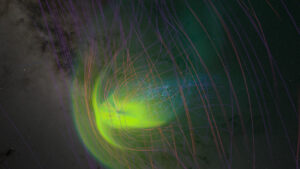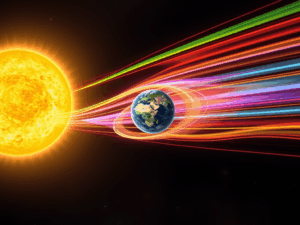Whooosh! The nitty-gritty about the solar wind for us ham radio operators, but packing in actual science.
The solar wind isn’t just a gentle breeze; it’s a continuous stream of charged particles – primarily protons and electrons – that are ejected from the Sun’s upper atmosphere, the corona. This stream travels outwards through the solar system at incredible speeds, typically ranging from 300 to 700 kilometers per second, but during solar events, it can get much faster.
Sun, big gravity, no? The Sun’s corona is super hot, millions of degrees Celsius. At these temperatures, the gas is ionized (electrons are stripped from atoms), creating a plasma. This plasma has enough energy to overcome the Sun’s gravity and stream out into space along the Sun’s magnetic field lines.
Here’s where it gets relevant to your radio waves. When this solar wind reaches Earth, it interacts with our planet’s magnetosphere, that protective magnetic bubble surrounding us. Most of the solar wind is deflected around the magnetosphere, which is a good thing for life on Earth. However, some of these charged particles can get caught in the magnetosphere and are funneled towards the Earth’s magnetic poles.
As these energetic particles collide with atoms and molecules in our upper atmosphere, particularly in the ionosphere (roughly 60 to 1000 km above the surface), they cause ionization – they knock more electrons loose. This increased ionization can significantly affect the propagation of High Frequency (HF) radio waves (typically 3 to 30 MHz) that we hams rely on for long-distance communication.
Here’s how a heightened solar wind can mess with your signals:
- Increased Absorption: A denser ionosphere due to increased ionization can lead to greater absorption of HF radio waves, weakening your signals, especially on lower frequencies. Think of it like your signal having to fight its way through a thicker, more energy-absorbing layer.
- Ionospheric Storms: Strong bursts of solar wind, often associated with coronal mass ejections (CMEs), can trigger ionospheric storms. These storms cause significant and rapid changes in the density and structure of the ionosphere. This can lead to:
- Signal Scintillation: Rapid fluctuations in the strength and phase of your signals, making them sound distorted or unstable.
- Auroral Absorption: In high-latitude regions, the increased particle precipitation along magnetic field lines can cause strong absorption of HF signals, sometimes making communication impossible. This is linked to the beautiful but radio-disrupting aurora borealis (Northern Lights) and aurora australis (Southern Lights).
- Changes in Maximum Usable Frequency (MUF): The MUF, the highest frequency that can be reflected by the ionosphere for long-distance communication, can fluctuate wildly during solar wind events. Sometimes it goes up, sometimes it plummets, making it tricky to find a reliable frequency.
Geomagnetic Disturbances: The interaction of the solar wind with Earth’s magnetosphere can also cause geomagnetic disturbances, which are fluctuations in the Earth’s magnetic field.

These disturbances can induce currents in the ground and in long conductors (Overhead Power Lines AND your COAX), potentially affecting radio equipment and even power grids in extreme cases (though this is less of a direct impact on HF propagation itself).
Scientific Nerd info
The solar wind is a continuous outflow of plasma, primarily composed of protons and electrons, from the Sun’s corona. This plasma stream carries with it a portion of the Sun’s magnetic field, known as the Interplanetary Magnetic Field (IMF). The solar wind originates from the extremely high temperatures of the corona (millions of Kelvin), which impart enough kinetic energy to the charged particles to escape the Sun’s gravitational pull. Its velocity typically ranges from 300 to 700 km/s, and its density near Earth’s orbit is around 5-10 particles per cubic centimeter.
The interaction of the solar wind with Earth’s magnetosphere is complex. The magnetosphere acts as a shield, deflecting most of the solar wind plasma. However, energy and particles can be transferred into the magnetosphere through processes like magnetic reconnection, particularly when the IMF has a southward component that opposes Earth’s magnetic field.
This transfer of energy and particles has significant consequences for the ionosphere, a layer of Earth’s upper atmosphere (approximately 60 to 1000 km altitude) that is crucial for High Frequency (HF) radio wave propagation (3-30 MHz). The ionosphere contains a significant concentration of ions and free electrons produced by solar electromagnetic radiation (primarily EUV and X-rays).
Here’s how variations in the solar wind can affect HF radio propagation:
1. Enhanced Ionization: Increased solar wind activity, especially during periods of high solar activity (e.g., solar flares, coronal mass ejections – CMEs), leads to a greater influx of energetic particles into the magnetosphere. These particles precipitate along Earth’s magnetic field lines towards the polar regions, colliding with atmospheric gases and causing additional ionization in the D and E layers of the ionosphere.
- D-layer Absorption: The D-layer (approximately 60-90 km) is primarily responsible for absorbing HF radio waves, especially at lower frequencies. Increased ionization in this layer due to enhanced solar wind activity and associated solar events leads to greater absorption, resulting in weaker signals and potentially blackouts, particularly on the sunlit side of the Earth. This effect is more pronounced at lower HF frequencies.
- E-layer Effects: While the E-layer (approximately 90-150 km) can contribute to HF propagation through sporadic-E (Es) ionization, significant disturbances from the solar wind can disrupt its regular behavior, leading to unpredictable signal reflections and scattering.
2. Ionospheric Storms: Geomagnetic storms, triggered by large-scale disturbances in the solar wind (often associated with CMEs), cause significant perturbations in the Earth’s magnetosphere and ionosphere. These storms can lead to:
- F-layer Disturbances: The F-layer (approximately 150-1000 km), particularly the F2 region, is the primary layer responsible for long-distance HF propagation through refraction. During ionospheric storms, the electron density of the F2 layer can fluctuate dramatically. This can cause the Maximum Usable Frequency (MUF) to vary widely, making it challenging to find stable propagation paths. The F2 layer can also become turbulent, leading to signal fading and distortion.
- Auroral Effects: The energetic particles from the solar wind that are funneled towards the magnetic poles cause ionization and excitation of atmospheric gases, resulting in the aurora borealis and australis. These auroral events are often accompanied by strong absorption of HF radio waves in the polar regions, making long-distance communication over or near these areas difficult or impossible. Auroral backscatter can also occur, where signals are reflected from the auroral ionization, often with distorted characteristics.
- Spread F: Ionospheric irregularities, known as Spread F, can be enhanced during geomagnetic storms. These irregularities scatter HF radio waves, leading to signal fading and reduced signal strength, particularly at higher HF frequencies and in equatorial regions.
3. Geomagnetic Indices: The intensity of geomagnetic disturbances caused by the solar wind is often quantified using geomagnetic indices like the Kp and Ap indices. Higher values of these indices indicate a more disturbed geomagnetic field and a higher likelihood of adverse effects on HF propagation.
In summary, the solar wind, particularly during periods of increased solar activity, directly influences the ionization levels and stability of the ionospheric layers responsible for HF radio wave propagation. Understanding solar wind conditions and monitoring space weather forecasts are essential for ham radio operators to anticipate and mitigate potential disruptions to their communications.
The CME and the aftermath
The CME as the yellow cloud from the Sun approaches. This disrupts the normal magnetic lines and causes ‘reconnects’ of the Earths’ magnetic field, shown in the video as a bright flash. This disturbance travels back to earth and causes distrubances in the ionosphere affecting HF.
When a Coronal Mass Ejection (CME) hits Earth, expect these impacts on your HF (0-30 MHz) ham radio operations:
- Geomagnetic storms will disrupt the ionosphere, which is vital for HF propagation.
- Propagation conditions will worsen, leading to poor signal quality and reduced range, especially on lower bands.
- Signal fading and increased noise will make clear communications tough.
- Enhanced aurora can occur at lower latitudes, affecting HF signals and causing irregular propagation.
- Frequency shifts may require you to retune as the ionosphere changes.
- Interference will increase due to solar activity generating more noise.
Be prepared for disruptions, especially during contests or emergency communications.
In a Nutshell for the Radio Ham:
The solar wind is a powerful stream of charged particles that directly influences the very layer of our atmosphere that makes long-distance HF communication possible. Keeping an eye on solar activity and space weather reports is crucial for understanding when and how this “wind” might impact your ham radio operations.
Places like NOAA’s Space Weather Prediction Center (SWPC) provide real-time data and forecasts that can help you anticipate these effects, and of course SolarCdx.com



